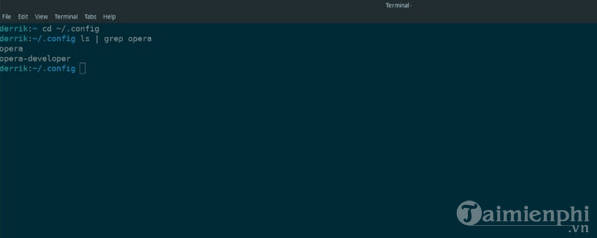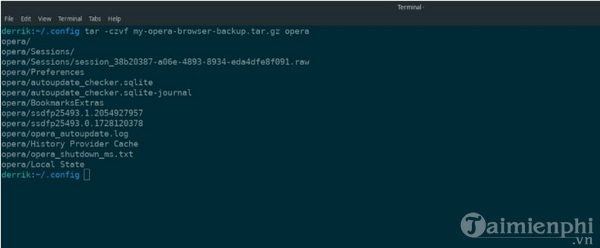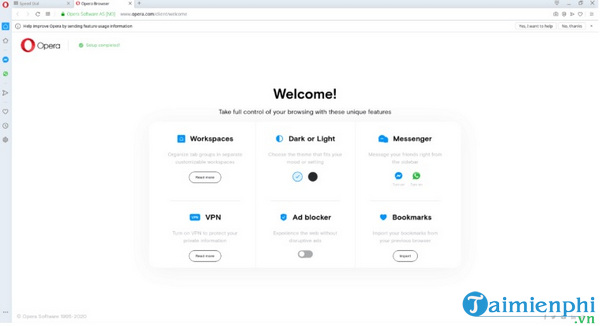Backup Opera browser settings on Linux
Continue reading the article below to learn detailed steps to backup Opera browser settings on Linux via Terminal and Tar command.
Article Table of Contents:
1. Backup Opera browser settings on Linux.
2. Compress browser files using the Tar command.
3. Encrypt backup.
4. Restore backup.
1. Backup Opera browser settings on Linux
To backup Opera browser settings, the first step you need to do is close the browser window on your Linux computer. This is because during use the browser will create files in the Linux file system.
The next step is to access Terminal using the key combination Ctrl + Alt + T or Ctrl + Shift + T.
On the Terminal window, enter the CD command and move the current Terminal window session from the (-) home directory to the -/.config directory . This directory contains all browser configuration files.
In the -/.config directory , run the ls command and look for the "opera" directory to ensure that the Opera browser configuration files on your Linux computer are in the -/.config directory:
ls
In case you run the ls command and the result is The result returns too many different folders and files, you can run a combination of the ls command with the grep command to filter unnecessary folders and files:
ls | grep opera

If the command does not display the opera folder, it means that the browser configuration files are not available on your Linux computer. Now you will have to add a browser login step before creating a backup.
2. Compress browser files using the Tar command
Before uploading browser data to backup services, you should take the additional step of compressing this data to avoid problems with failed data uploads. Furthermore, compressed files are easier to encrypt.
Follow the steps below to compress browser files:
First run the CD command to move into the -/.config directory:
cd -/.config
In the -/.config directory , run the command below to create a compressed file containing Opera browser settings:
tar -czvf my-opera-browser-backup.tar.gz opera

After the command finishes running, it will output a TarGZ file named my-opera-browser-backup.tar.gz in the -/.config directory . The next step uses the mv command to move files from the -/.config directory to the home directory .
mv my-opera-browser-backup.tar.gz -/
Now you can upload files to cloud storage services (Dropbox, Google Drive, iCloud, .) or store them on an external hard drive to ensure file safety. A small note is that the file is not encrypted, so anyone can decompress and access your browser data.
3. Encrypt backup
As mentioned above, the my-opera-browser-backup.tar.gz file is not encrypted, which means anyone can access your Opera browser settings. To encrypt the file we will use the GPG command.
If your computer does not have GPG installed, go here to download and install.
Follow the steps below to encrypt the my-opera-browser-backup.tar.gz file:
Step 1: Run the command below to make sure your computer has GPG installed:
Step 2: Run the CD command to move Move the Terminal window from the -/.config directory to the home directory (-):
cd -/
Step 3: Use the gpg -c command to encrypt the my-opera-browser-backup.tar.gz file. In addition, TipsMake recommends that you use a strong password:
gpg -c my-opera-browser-backup.tar.gz
The output file is in the form my-opera-browser-backup.tar.gz.gpg .
Step 4 : Run the command below to delete unencrypted files:
rm my-opera-browser-backup.tar.gz
4. Restore backup
To restore a backup of Opera browser settings, follow the steps below. Note that if the backup file is not encrypted, you can skip steps 1 and 2.

Step 1: Use the Linux file manager to move the encrypted file my-opera-browser-backup.tar.gz.gpg to the home directory (-).
Step 2: Next step open the Terminal window and run the gpg command to decrypt the file my-opera-browser-backup.tar.gz.gpg: gpg my-opera-browser-backup.tar.gz.gpg
Step 3 : Use Use the tar xvf command to decompress the decrypted TarGZ Opera backup file in the home directory:
tar xvf my-opera-browser-backup.tar.gz
After the Tar command decompresses the backup file, additional information will be displayed in the home directory. folder named " opera ". This folder contains all Opera browser data.
Step 4 : Use the mv command to move the "opera" folder into the -/.config directory:
mv opera/ -/.config
In the above article, we have just guided you through the steps to backup Opera browser settings on Linux. Hope the above article has provided you with useful information. In addition, if you have any questions or concerns like how to install Google Chrome on Linux , readers can leave their comments in the comments section below the article.
You should read it
- How to install Chrome utility on Opera browser
- Learn about Opera page: of Opera browser
- The brand new way to use Opera One
- What is Opera One web browser? What can it do?
- How to use the new Opera Neon web browser
- How to Uninstall Opera
- How to Install Tor Browser on Linux
- How to open a screenshot folder on Opera Neon
May be interested
- Learn about the Opera GX gaming browser
 opera has just released opera gx version and advertises it as the first gaming browser in the world. in addition to a gaming-inspired theme and integrated razer chroma, there's also a very interesting feature on cpu and ram limitations.
opera has just released opera gx version and advertises it as the first gaming browser in the world. in addition to a gaming-inspired theme and integrated razer chroma, there's also a very interesting feature on cpu and ram limitations. - Which Opera browser should you use in Android?
 did you know that only about 2% of internet users use opera browser? if you are one of these few people, you may have considered using this favorite browser for android.
did you know that only about 2% of internet users use opera browser? if you are one of these few people, you may have considered using this favorite browser for android. - Opera 11.60 pleases technology enthusiasts
 appearing at the holiday season, opera software is proud to release opera 11.60, the latest version of opera for desktop browsers. nearly 50% of the world's population has never tried a new browser, why don't you help them discover something better this year?
appearing at the holiday season, opera software is proud to release opera 11.60, the latest version of opera for desktop browsers. nearly 50% of the world's population has never tried a new browser, why don't you help them discover something better this year? - I have switched from Chrome to Opera and will never regret it
 what makes users want to switch from chrome to using opera browser? read the article below for more information!
what makes users want to switch from chrome to using opera browser? read the article below for more information! - Opera 21 launches Windows and Mac users with many new features
 opera recently released the latest version of opera browser for windows and mac users. today's version of opera 21 promises to make the animation smoother and more beautiful, thanks to aura hardware acceleration technology.
opera recently released the latest version of opera browser for windows and mac users. today's version of opera 21 promises to make the animation smoother and more beautiful, thanks to aura hardware acceleration technology. - Opera Mini 8 improves interface and better support for popular phones
 opera software has announced that it has released a new version of opera mini browser, opera mini 8, which mainly supports the java platform on popular phones.
opera software has announced that it has released a new version of opera mini browser, opera mini 8, which mainly supports the java platform on popular phones. - Opera launched new updates for Android devices with many noticeable improvements
 opera has officially released a new update for android users (verson 50).
opera has officially released a new update for android users (verson 50). - Set up Safari or Opera as the system's default browser
 in the previous tutorial, we presented the basic steps to change the default browser settings in windows with firefox, chrome and internet explorer, and this time, we will continue with the other two browsers: that's opera and safari ...
in the previous tutorial, we presented the basic steps to change the default browser settings in windows with firefox, chrome and internet explorer, and this time, we will continue with the other two browsers: that's opera and safari ... - Reviews on Opera VPN: Simple, fast and free
 maybe you've heard that the opera web browser comes with a free vpn, or maybe you're an opera lover and just want to know how their vpn service works.
maybe you've heard that the opera web browser comes with a free vpn, or maybe you're an opera lover and just want to know how their vpn service works. - Opera One is now available on iPhone
 opera has released its new redesigned opera one browser for ios. after beta testing for weeks, opera one for ios is now available in a stable version.
opera has released its new redesigned opera one browser for ios. after beta testing for weeks, opera one for ios is now available in a stable version.










 How to install LibreOffice on Ubuntu, Linux Mint
How to install LibreOffice on Ubuntu, Linux Mint How to record computer and laptop screens with sound and edit videos
How to record computer and laptop screens with sound and edit videos How to record video from webcam on Ubuntu, Linux
How to record video from webcam on Ubuntu, Linux How to check Linux computer configuration
How to check Linux computer configuration Top 4 best password management software to use
Top 4 best password management software to use Top best password managers for Linux
Top best password managers for Linux